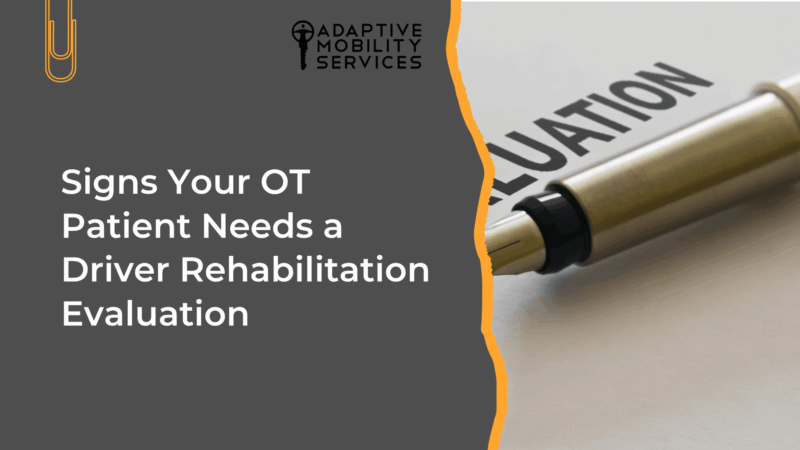
Signs Your OT Patient Needs a Driver Rehabilitation Evaluation
As an Occupational Therapist, you already know how critical independence is to the lives of your patients. One area that is often overlooked is safe driving, but this easily has a large impact.
Being able to recognize when a patient may need a driver rehabilitation evaluation is not just a valuable skill. It is an excellent opportunity to expand your clinical expertise.
Signs Your Patient May Need a Driver Rehab Eval
A patient may not always voice concerns about driving on their own. You as an OT can look for certain signs that may indicate they are struggling.
- Recent Medical Events: A stroke, orthopedic injuries, traumatic brain injuries, or vision changes can impact driving ability.
- Cognitive or Memory Challenges: Difficulty with attention, reaction time, or multitasking may affect how decisions are made while behind the wheel.
- Physical Limitations: Handling a vehicle could be unsafe if a patient currently has weakness, a limited range of motion, or coordination challenges.
- Medication Side Effects: Some medications might cause drowsiness, slower reaction time, or vision issues that could negatively impact driving.
- Family or Self-Reported Concerns: A patient’s loved ones may notice your patient is avoiding driving, causing minor accidents, or feeling anxious about driving.
Recognizing signs like these is one thing. Knowing how to intervene effectively is another.
Reflect on Your OT Skills
You may need to ask yourself:
- “Do I feel confident assessing a patient’s driving potential?”
- “Am I equipped to recommend adaptive equipment or modifications?”
- “Can I help patients regain independence safely?”
If you are not sure or you would like to learn more, now may be the right time to expand your expertise. While traditional OT experience can provide a strong foundation, driver rehabilitation requires further specialized skills to ensure safe outcomes.
Why Training Matters
Becoming an OT Driver Rehabilitation Specialist allows you to bridge the gap between traditional therapy and real-world independence. With proper training, you’ll learn how to:
- Carry out thorough driving assessments
- Recommend adaptive equipment or vehicle modifications
- Create safe driving plans for patients alongside their families
- Increase your confidence in clinical decision-making related to driving
Training with Adaptive Mobility provides mentorship and hands-on guidance to help you transition from a traditional OT role to becoming a certified OT DRS. With the support of an experienced mentor like Susie Touchinsky, you will gain confidence and refine your skills. In no time, you will be able to help patients with safe driving, allowing them to regain or maintain one of the most important aspects of their independence.
Take the Next Step
If you’re seeing patients who may benefit from a driver rehabilitation evaluation, consider expanding your expertise. Even if you are not but are just wondering whether your OT skills can be even more impactful in a unique role, Adaptive Mobility’s mentorship and training program can guide you through the transition.
Meet Susie!

Susie Touchinsky, OTR/L, SCDCM, CDRS, is an established expert in both occupational therapy and driver rehabilitation. She has been an OT for more than 20 years and brings expertise and a love for helping others in her speeches and trainings.
Learn More With Our OT Driver Rehabilitation Specialist Courses
Try Our Free OT DRS Courses:
- OTs Role With Driving
- GRID: Generalist Resource to Integrate Driving
- Readiness to Drive: IADL Checklist
- FREE 6 Driving Resources for the OT
- 5-Steps Our Clients Use to Start Their Own Highly-Paid OT Driver Rehab Business
- Driving Risk Screening Tools
- BCAT Brief Cognitive Assessment Test System Overview
- BCAT Part 2: CBS 8 & 15-for-Me
Become the best OT Driver Rehabilitation Specialist you can be by being a life long learner.
